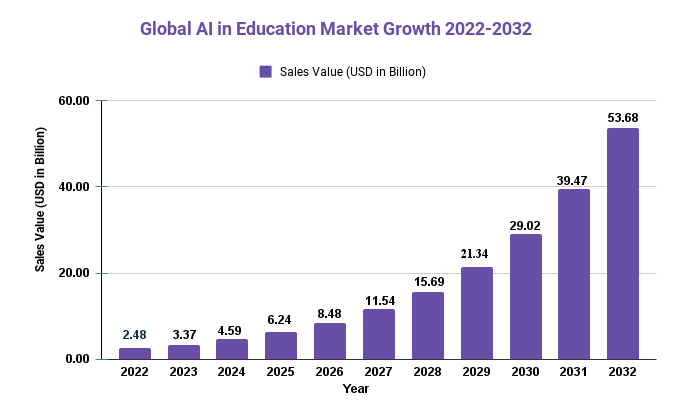AI in Education Market is forecast to reach a whopping USD 53.68 billion by 2032

Page Contents
Market Overview
Published Via 11Press: The AI in Education market is a rapidly rising segment of the EdTech industry. A report by Market.us states that the global AI in Education market size was valued at USD 2.48 billion in 2022 and is forecast to reach a whopping USD 53.68 billion by 2032, growing at an impressive compound annual growth rate (CAGR) of 36.0% over this forecast period.
The AI in Education market is being driven by several factors, such as the increasing adoption of digital learning, the demand for personalized experiences, and an urgent need to enhance educational quality. AI-powered educational solutions can address these challenges by offering tailored learning experiences, automating administrative tasks, and improving student engagement levels.

Regional Snapshot
- North America: North America has the largest market for AI in Education. The United States is its primary contributor. The growth of this market is due to the existence of major AI companies, greater adoption of digital learning, and rising demand for personalized learning.
- Europe: Europe ranks second in terms of AI in Education. France is leading the pack, as are Germany and the UK. This region is experiencing rapid growth due to the increased focus on e-learning, the adoption, and the demand for personalized Learning.
- Asia Pacific: Asia Pacific should experience the highest rate of growth during the forecast period. It is driven by increasing adoptions of digital learning, such as in China, India, Japan, and other countries. In the region, there is a rise in government initiatives to improve education. This is driving the adoption of AI in education.
- Middle East, Africa: Middle East/Africa is experiencing growth in AI in Education. This is due in part to an increased focus on education and the use of e-learning.
- Latin America: Latin America has a growing demand for e-learning solutions. This is driving AI in Education. Brazil is currently the largest market in AI in Education in the region.
Drivers
- Increased adoption of digital learning: Digital learning solutions are being adopted more frequently in educational institutions across the globe, which is driving the growth of AI in the Education Market. The demand for AI-powered educational software that can improve learning outcomes and personalize learning experiences is growing as more educational institutions adopt online learning.
- Personalized learning is in demand: Because students have different learning styles, preferences, and learning methods, there is a rising demand for such personalized learning. AI-powered educational systems can tailor learning experiences to meet the individual needs of students.
- Education quality needs to be improved: There is increasing recognition of the need for education quality to improve. Technology can play a crucial role in this. AI-powered education solutions can increase the quality and effectiveness of education by offering better learning experiences and improving student outcomes.
- Investment in AI: Over the past several years, there has been a sharp increase in investment in AI as technology businesses and educational institutions make significant investments in educational solutions powered by AI. The development of innovative AI-powered educational solutions is being fueled by this investment.
- Automation of Administrative Tasks: Artificial intelligence (AI)-powered educational systems can automate administrative tasks like grading and evaluation, providing teachers more time to concentrate on more crucial tasks like teaching or mentoring students.
Restraints
- Implementation and Integration Challenges: Implementing AI into education necessitates a significant investment in technology and infrastructure. Unfortunately, many educational institutions may lack the resources to procure, install, and support necessary hardware and software components.
- Limited Data Accessibility: AI algorithms require large amounts of data to train and improve their precision. Unfortunately, educational records are often incomplete or fragmented, making it difficult for AI to provide meaningful insights.
- Privacy and Security Concerns: As AI applications in education become more commonplace, there are growing worries about the privacy and security of student data. Institutions must guarantee their data collection and usage practices adhere to regulations while protecting student privacy.
- Lack of Standardization: Unfortunately, there is a lack of uniformity when it comes to AI tools and platforms available for education, making it difficult for institutions to compare and assess different products.
- Ethical Considerations: AI systems may promote biases or stereotypes if not designed and implemented with care. Therefore, it is essential that AI in education is utilized ethically and responsibly.
Opportunities
- Personalized Learning: AI can analyze student data to create personalized learning paths tailored to individual needs, styles, and interests. This could result in improved student engagement as well as academic performance.
- Automated Assessment: AI can automate the grading of assessments, freeing teachers' time and providing faster feedback to students. Furthermore, AI provides more precise and objective grading.
- Intelligent Tutoring: AI-powered tutoring systems can offer real-time feedback, answer student queries, and offer personalized recommendations. This improves student learning outcomes while decreasing the need for one-on-one tutoring sessions.
- Predictive Analytics: AI can analyze data from various sources to forecast student performance and identify areas for improvement. This allows teachers to intervene early and prevent students from falling behind.
- Virtual Assistants: AI-powered virtual assistants can offer students quick answers to their questions and personalized recommendations for further learning, improving the student learning experience and supporting remote learning initiatives.
- Smart Content: AI can assist in crafting and curating content tailored to each learner's individual needs, interests, and abilities. This makes learning more engaging, pertinent, and efficient.
Challenges
- Lack of Trust: Some stakeholders in the education market, such as teachers and parents, may be hesitant to trust AI-powered systems for educational purposes. To foster trust and educate these stakeholders on both its advantages and potential drawbacks, it is essential to build rapport.
- Biases and Discrimination: AI algorithms can perpetuate prejudices and discrimination, particularly if the data used to train them is biased. Therefore, it's essential that AI systems be created and implemented ethically and responsibly.
- Data Privacy and Security: As AI applications in education become more prevalent, concerns have arisen regarding the privacy and security of student data. Educational institutions must ensure their data collection and usage practices adhere to regulations while safeguarding student privacy.
- Implementation Challenges: Integrating AI into education necessitates a substantial investment in both technology and infrastructure. Educational institutions may lack the resources or expertise necessary to properly implement and support AI-powered systems.
- Lack of Standardization: Unfortunately, the AI tools and platforms available for education lack standardization, making it difficult for educational institutions to compare and assess different products.
- Impact on Teacher Roles: As AI becomes more widely utilized in educational settings, it will likely alter the roles and responsibilities of teachers. Therefore, it's essential that they receive adequate training and tools so they are able to work alongside AI systems effectively.
Key Market Segments
Type
- Cloud-Based
- On-Premises
Application
- Virtual Facilitators and Learning Environments
- ITS
- CDS
- Fraud and Risk Management
Key Market Players
- IBM (US)
- Microsoft (US)
- Bridge-U (UK)
- DreamBox Learning (US)
- Fishtree (US)
- Jellynote (France)
- Jenzabar (US)
- Knewton (US)
- Metacog (US)
- Querium Corporation (US)
- Google (US)
- AWS (US)
- Cognizant (US)
- Carnegie Learning (US)
- Century-Tech (UK)
- Cognii (US)
- Elemental Path (US)
- Liulishuo (China)
- Nuance Communications (US)
- Osmo (US)
Report Scope
| Report Attribute | Details |
| The market size value in 2022 | USD 2.48 Bn |
| Revenue forecast by 2032 | USD 53.68 Bn |
| Growth Rate | CAGR Of 36.0% |
| Regions Covered | North America, Europe, Asia Pacific, Latin America, and Middle East & Africa, and Rest of the World |
| Historical Years | 2017-2022 |
| Base Year | 2022 |
| Estimated Year | 2023 |
| Short-Term Projection Year | 2028 |
| Long-Term Projected Year | 2032 |
Frequently Asked Question
Q: What is the current market size for Global AI in Education Market?
A: According to a report by Market.us, the Global AI in Education Market was valued at USD 2.48 billion in 2022 and is expected to reach USD 53.68 billion by 2032, growing at a CAGR of 36.0% during the forecast period.
Q: What are the key segments of the Global AI in the Education Market?
A: The Global AI in Education Market can be segmented based on Type (Cloud Based, On-Premises), By Application (Virtual Facilitators and Learning Environments, ITS, CDS, Fraud and Risk Management), and geography (North America, Europe, Asia-Pacific, Latin America, and Middle East & Africa).
Q: Who are the key players in the Global AI in Education Market?
A: Some of the key players in the Global AI in Education Market include IBM (US), Microsoft (US), Bridge-U (UK), DreamBox Learning (US), Fishtree (US), Jellynote (France), Jenzabar (US), Knewton (US), Metacog (US), Querium Corporation (US), Google (US), AWS (US), Cognizant (US), Carnegie Learning (US), Century-Tech (UK), Cognii (US), Elemental Path (US), Liulishuo (China), Nuance Communications (US), Osmo (US).
The team behind market.us, marketresearch.biz, market.biz and more. Our purpose is to keep our customers ahead of the game with regard to the markets. They may fluctuate up or down, but we will help you to stay ahead of the curve in these market fluctuations. Our consistent growth and ability to deliver in-depth analyses and market insight has engaged genuine market players. They have faith in us to offer the data and information they require to make balanced and decisive marketing decisions.